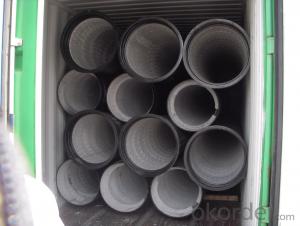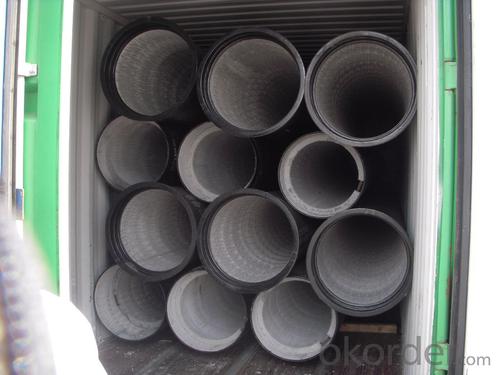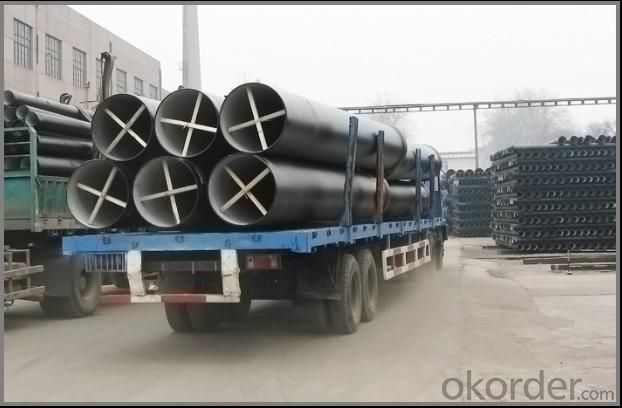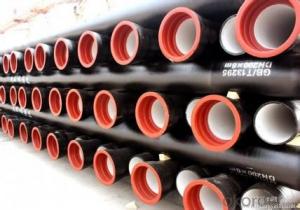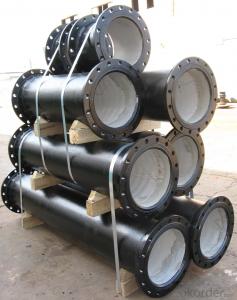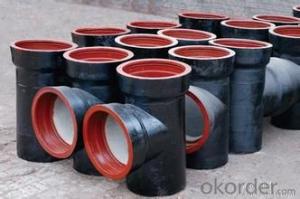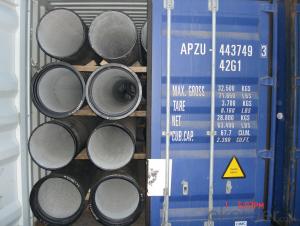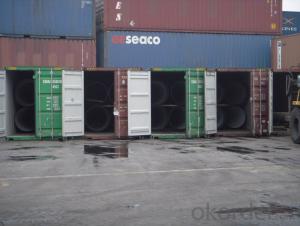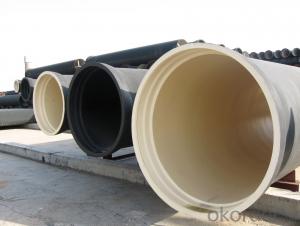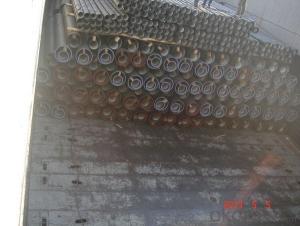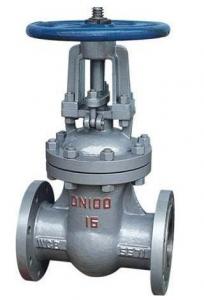DUCTILE IRON PIPES C Class DN150
- Loading Port:
- China Main Port
- Payment Terms:
- TT OR LC
- Min Order Qty:
- -
- Supply Capability:
- -
OKorder Service Pledge
OKorder Financial Service
You Might Also Like
Ductile Iron Cast Pipe is without any defects compare with tradition casting tech, which has many advantages particularly as follow:
(1) High density. In the "vertical upward casting" process, the melt iron of centre liquid column in center crystallizer is continuously feeding for volume shrinkage caused by condensation tube at outer circumference , which lead to be free of shrinkage porosity.
(2) High purity. When melt iron pouring, the mixed impurities such as gas, dross, sand grain which are lighter than melt iron could be eliminated at furnace mouth, its impossible to enter into the crystallizer through the channel, so the melt iron into the crystallizer is very pure.
(3) Strength with toughness. The cooling speed provided by continuous crystallizer is 30 times than sand casting and 5 times than centrifugal casting, and doesn't produce white iron, the eutectic cell volume of continuous cast iron is one eighth to one tenth compare with traditional cast iron. The density of graphite nodule in ductile iron can reach 300-700 pcs/mm2. Therefore, all reason above improve the strength and toughness of continuous cast iron.
(4) Free machining. The high speed cooling make the hardening phase (such as boride, steadite) not appear like reticular, massive or thick, but diffuse like fish bone and pane in shape, moreover, there are tiny graphite flakes inlaid hardening phase. It's free machining in BrinellHardness the range of 250-300HB. However, the Brinell Hardness of 250 is top limit to common metal materials.
(5) Uniform composition of tube wall. The convection mixing of liquid column caused by marching type drawing in crystallizer make the composition of tube wall well-distributed, and concentration gradient very little.
(6) High productivity. To the wall thickness of tube under 10mm, the speed of continuous casting is 1 meter/min, to the wall thickness of tube under 20mm, the speed of continuous casting is 0.5 meter/min, which is high efficiency that centrifugal or other casting tech couldn't reach.
- Q: How are ductile iron pipes protected against mechanical damage?
- Ductile iron pipes are protected against mechanical damage through various measures that ensure their durability and longevity. One common method is the application of a protective coating on the exterior surface of the pipes. This coating acts as a barrier, shielding the ductile iron from physical abrasion, impact, and corrosion. The coating can be made of materials like epoxy, polyethylene, or zinc, depending on the specific requirements and environmental conditions. In addition to the protective coating, ductile iron pipes are also designed with a high level of structural strength. They are manufactured to withstand significant pressure and external forces, making them less susceptible to mechanical damage. The inherent strength of the material allows the pipes to resist deformation and cracking, even under heavy loads or ground movements. Furthermore, ductile iron pipes are often installed using proper bedding and backfilling techniques. This involves placing the pipes in a carefully prepared trench, ensuring a stable foundation and minimizing the risk of external forces causing damage. The correct backfill material is then used to provide support and prevent excessive pressure on the pipes. To enhance protection against mechanical damage, ductile iron pipes are often installed with additional measures such as concrete encasement or protective sleeves. Concrete encasement involves placing a layer of concrete around the pipe, providing an extra layer of protection against external forces. Protective sleeves can also be used in areas prone to impact or where additional protection is required. Regular inspections and maintenance are crucial in ensuring the continued protection of ductile iron pipes against mechanical damage. Periodic checks for any signs of wear, corrosion, or other forms of damage allow for timely repairs or replacement, preventing further deterioration. Overall, a combination of protective coatings, structural strength, proper installation techniques, and regular maintenance helps protect ductile iron pipes against mechanical damage, ensuring their reliable performance and longevity in various applications.
- Q: Are ductile iron pipes suitable for use in desalination plants?
- Desalination plants necessitate a dependable and long-lasting piping system to convey treated water to various destinations. Ductile iron pipes, famed for their strength, flexibility, and corrosion resistance, are truly an ideal choice for such plants. These pipes, crafted from a variant of cast iron fortified with magnesium, possess a heightened tensile strength that allows them to endure the pressures linked to the desalination process. Additionally, desalination plants often employ chemicals and other treatment methods to eliminate impurities from the water. Ductile iron pipes exhibit remarkable resistance to corrosion caused by these chemicals and can endure the harsh conditions present in desalination plants without deteriorating over time. This ensures the longevity and dependability of the piping system, consequently minimizing the chances of leaks or failures. Moreover, ductile iron pipes feature a sleek inner surface, which aids in diminishing friction and pressure loss during water flow. This aspect carries significant importance in desalination plants, where efficiency is paramount for the overall functioning of the facility. The smoothness of ductile iron pipes facilitates efficient water flow, thereby reducing energy consumption and optimizing the desalination process. In conclusion, ductile iron pipes are an appropriate choice for utilization in desalination plants due to their strength, flexibility, corrosion resistance, and smooth inner surface. These pipes provide a reliable and durable piping system capable of withstanding the elevated pressures, harsh chemicals, and demanding conditions prevalent in desalination plants.
- Q: Can ductile iron pipe be used for desalination plants?
- Yes, ductile iron pipe can be used for desalination plants. Ductile iron has excellent corrosion resistance properties, making it suitable for handling the corrosive nature of desalinated water. Additionally, its high strength and durability make it a reliable choice for transporting water in such plants.
- Q: Do ductile iron pipes require internal linings for potable water?
- No, ductile iron pipes do not require internal linings for potable water. Ductile iron is a type of iron that has been treated to enhance its strength and flexibility. It is commonly used for water distribution systems due to its durability and resistance to corrosion. Unlike other materials, such as cast iron or steel, ductile iron pipes have a protective layer called a cement-mortar lining, which provides an effective barrier against corrosion and prevents the leaching of any harmful substances into the water. This lining is applied during the manufacturing process and is designed to withstand the corrosive properties of potable water, making internal linings unnecessary. Additionally, the smooth surface of ductile iron pipes helps to maintain the quality and flow of water without the need for additional linings.
- Q: What are the disadvantages of using ductile iron pipe?
- There are several disadvantages associated with using ductile iron pipe. Firstly, one major drawback is its cost. Ductile iron pipe tends to be more expensive than other types of piping materials such as PVC or even traditional cast iron. This can make it less appealing for projects with strict budget constraints. Secondly, ductile iron pipe is relatively heavy compared to other materials. This makes it more difficult to handle and install, requiring specialized equipment and additional labor. The weight can also make it more susceptible to damage during transport and installation. Another disadvantage is its susceptibility to corrosion. While ductile iron is more resistant to corrosion than traditional cast iron, it is still prone to rust and deterioration over time. This can lead to reduced lifespan and potential leaks or pipe failures. Additionally, ductile iron pipe has limited flexibility and is not as resistant to ground movement or settlement. This can result in cracking or breaking of the pipe, especially in areas with unstable soil conditions or seismic activity. Lastly, ductile iron pipe can have a rough interior surface, which can lead to increased friction and reduced flow capacity. This can result in higher pumping costs and decreased efficiency in fluid transportation. Overall, while ductile iron pipe has its advantages, such as its strength and durability, these disadvantages should be carefully considered when choosing the appropriate piping material for a specific project.
- Q: What is the average diameter range of ductile iron pipes?
- The average diameter range of ductile iron pipes can vary depending on the specific application and industry standards. However, in general, ductile iron pipes are available in a wide range of diameters to meet various requirements. Commonly, the average diameter range for ductile iron pipes can start from as small as 4 inches (100 mm) and go up to 64 inches (1600 mm) or even larger. These sizes are often used for water distribution, sewer systems, and other infrastructure projects. It is important to note that the specific diameter range of ductile iron pipes can be influenced by factors such as local regulations, project specifications, and engineering considerations. Therefore, it is recommended to consult industry standards and relevant authorities to determine the appropriate diameter range for a specific application.
- Q: Are ductile iron pipes resistant to chloride-induced corrosion?
- Yes, ductile iron pipes are resistant to chloride-induced corrosion. Ductile iron is a type of cast iron that has been treated with magnesium to make it more flexible and resistant to cracking. It has a ferritic microstructure which provides excellent resistance to corrosion caused by chlorides. Chloride-induced corrosion can occur when chloride ions in the water or soil come into contact with the metal surface, leading to the formation of corrosion products such as rust. However, the presence of magnesium in ductile iron forms a protective layer on the surface, preventing the chloride ions from reaching the metal and thus inhibiting corrosion. This makes ductile iron pipes suitable for a wide range of applications, including water supply and sewerage systems, where chloride exposure is common.
- Q: How can the steel plastic composite pipe be connected with the cast iron pipe?
- The hoop has the advantages of beautiful appearance, convenient operation, strong clamping force, good sealing performance, etc.. Mainly used for connecting and fastening vehicle, ship, diesel engine, gasoline engine, machine tools, fire, and other machinery and equipment, chemical equipment general nylon hose, plastic hose, hose cloth, water interface and seal etc..
- Q: Can ductile iron pipes be used in mining applications?
- Yes, ductile iron pipes can be used in mining applications. Ductile iron has high strength, durability, and resistance to corrosion, making it suitable for various underground mining operations. It can withstand the demanding conditions found in mining environments, including high pressure, abrasive materials, and harsh chemicals. Additionally, ductile iron pipes are cost-effective and have a long lifespan, making them a reliable choice for mining applications.
- Q: What is the weight of a typical ductile iron pipe?
- The weight of a typical ductile iron pipe can vary depending on its size and wall thickness. Generally, ductile iron pipes are available in sizes ranging from 3 inches to 64 inches in diameter. The weight of these pipes can range from a few pounds per foot for smaller sizes to several hundred pounds per foot for larger diameters. Wall thickness also plays a significant role in determining the weight of the pipe. Thicker walls will result in a heavier pipe. For instance, a 10-inch ductile iron pipe with a wall thickness of 0.25 inches may weigh around 26 pounds per foot, whereas a 24-inch ductile iron pipe with a wall thickness of 0.5 inches can weigh approximately 175 pounds per foot. It is important to consult specific manufacturer specifications or engineering references to determine the precise weight of a particular ductile iron pipe.
Send your message to us
DUCTILE IRON PIPES C Class DN150
- Loading Port:
- China Main Port
- Payment Terms:
- TT OR LC
- Min Order Qty:
- -
- Supply Capability:
- -
OKorder Service Pledge
OKorder Financial Service
Similar products
Hot products
Hot Searches
